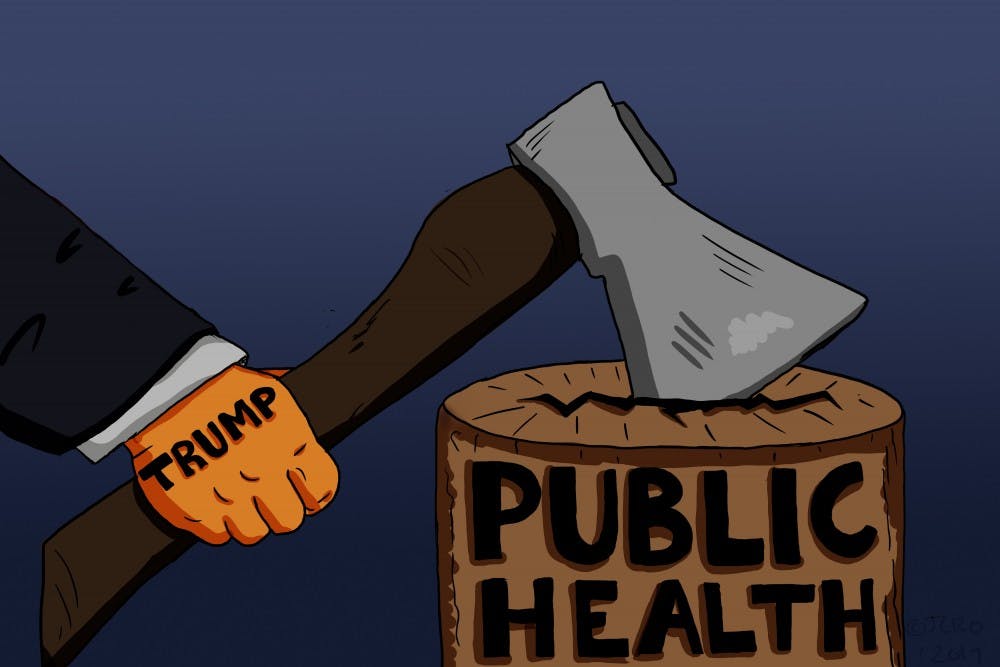When President Donald Trump nominated Tom Price to become Health and Human Services Secretary, public health was clearly not a major priority. Now, significant funding to ASU labs is at stake among myriad initiatives to protect Americans.
The Department of Health and Human Services is, to say the least, massive. Responsibility for administering Social Security, Medicaid and Medicare falls to the department, which accounted for 27.7 percent of the federal budget in fiscal year 2017.
While these programs represent its flagship core, DHHS's work goes far beyond the programs Americans see as taxes and government benefits.
These include programs such as the National Institutes of Health, a constellation of hospitals, universities and public and private researchers nationally examining health at every level of the population.
According to the NIH, ASU received $10.6 million in funding from the institutes in 2017. This funding provides resources for 36 studies including everything from preventing diabetes in Latino populations to the best methods to prepare patients for post-trauma brain surgery.
Kenja Hassan, director of Cultural Relations and Special Projects for ASU, is involved in researching health disparities. Her focus on differences in healthcare outcomes for different communities directly requires hyperspecific studies.
"Diabetes costs the healthcare system billions of dollars," Hassan said. "If you are able to understand the early onset and why it's happening to some people and not others, you can massively reduce the economic burden."
President Trump’s budget proposal, however, indicates that this administration does not see value in the NIH or other HHS programming. If Congress were to approve President Trump’s budget proposal as introduced, the DHHS discretionary programming — spending on research and non-entitlement programs — would be cut by 23 percent.
According to Bloomberg, these cuts would affect DHHS the most at $19.5 billion. Trump's budget puts everyday Americans last by further cutting health, education, public safety, environmental, housing and food spending to build a fortress of those damned to be living here and to defend the interests of the surviving robber barons abroad.
Only a paltry $5.8 billion of those will come from the NIH. The rest come from programs like the one responsible for keeping low-income Americans from freezing to death in the Minneapolis winter or dying of heat stroke here in the Arizona summer.
Again, the “fortress of those damned to be living here” was not a joke.
Public health is, as the name would suggest, integral to keeping the American public alive and healthy. While this budget does not include cuts to entitlement programs, those are also in the works even past the failed American Healthcare Act.
Part of the fault lies in the perception of public health as nothing more than funds for playgrounds.
The Right has complained for more than half a decade about DHHS’s Prevention and Public Health Fund, which was set up as part of the ACA to channel funds into anywhere public health could be affected.
Congress most strongly reacted against the fund because it gave the president and the rest of the executive branch guaranteed money to do as they pleased.
That fund was used by the federal government to influence local politics, which upset many as it served to help local groups coerce states and municipalities to implement horrible, nightmarish policies like tobacco bans.
Under a strictly federalist framework, that might be unpopular. Yet recent scholarship by Yale law professor Heather Gerken suggests this is just anger at money being used by a Democratic administration towards more liberal means.
On campus, these cuts are going to be most strongly felt at the Biodesign Institute, taking away research opportunities for both the students and faculty. Nonetheless, unlike runaway financial growth, federal budget cuts will trickle down to affect students.
Whether that be low-income students losing funding for essential housing assistance or an epidemic response more chaotic than last year’s Zika virus fiasco, these cuts demonstrate the importance of public health.
Amidst the spectacle of a global increase in violence and a spike in hate crime coverage, it’s easy to forget about public health outside of Biodesign. Students do so at their own peril.
Reach the columnist at benjamin.steele@asu.edu or follow @blsteele17 on Twitter.
Editor’s note: The opinions presented in this column are the author’s and do not imply any endorsement from The State Press or its editors.
Want to join the conversation? Send an email to opiniondesk.statepress@gmail.com. Keep letters under 500 words and be sure to include your university affiliation. Anonymity will not be granted.
Like The State Press on Facebook and follow @statepress on Twitter.




